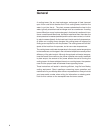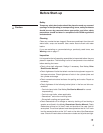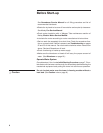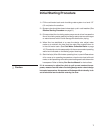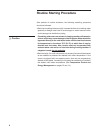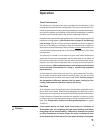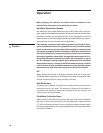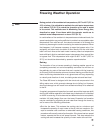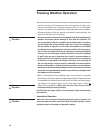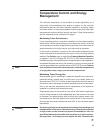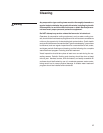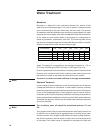
11
Freezing Weather Operation
During periods of low ambient air temperatures, 35°F to 40°F (2°C to
4°C) or below, it is advisable to maintain the cold water temperature
at or above 70°F (21°C) to retard the formation of ice and to assist
in its control. The methods used in Minimizing Tower Energy Use,
described on page 13 are those which the operator would use to
maintain water temperature at or above 70°F (21°C).
In combinations of low ambient air temperatures and reduced loads, fan
speed manipulation may not be sufficient to maintain an acceptable water
temperature. Even with fans off, the natural movement of air through the
tower may be enough to continue reducing the water temperature. When
that happens, it will become necessary to open the bypass valve, if so
equipped, and allow total circulation to flow directly into the cold water
basin until such time as the basin water inventory rises to a temperature
level sufficiently high to preclude frequent changeovers from normal flow
to bypass flow. That temperature level might be 85°F to 90°F (29°C to
32°C), but should be determined by operator experimentation.
Deicing
The formation of ice on towers operating in freezing weather cannot be
completely prevented, but can be acceptably controlled. Ice will form on
the relatively dry parts of the tower that are in contact with the incoming
air. Primarily, this includes the columns, structural framing, and fill at the air
inlets. Ice forming characteristics on any given tower will vary, depending
on velocity and direction of wind, circulating water rate and heat load.
The Class 800 tower is designed with few structural components in the
falling water zone, which prevents damage due to falling ice. However,
structural damage can still result from excessive buildup of ice attached
to the fill.
A regularly programmed inspection (one walk around the tower per shift)
during cold weather operation is the best way to determine if ice buildup
on the fill is occurring. If ice is observed and determined to be acceptable,
maintain full (total) design flow over the tower. Excessive ice formation
may be controlled by regulating air and water flow through the tower by
one or more of the following procedures:
• Shut the fan down. This reduces the cooling rate to a minimum and
increases the quantity of warm water at the air inlet to a maximum. Ex-
cept for extreme cold conditions or extended freezing conditions, this
procedure will normally control ice formation. If the tower has two-speed
motors, operate the fan at half speed forward. This also reduces the
cooling rate and increases the quantity of warm water at the air inlet.
➠
▲ Note




